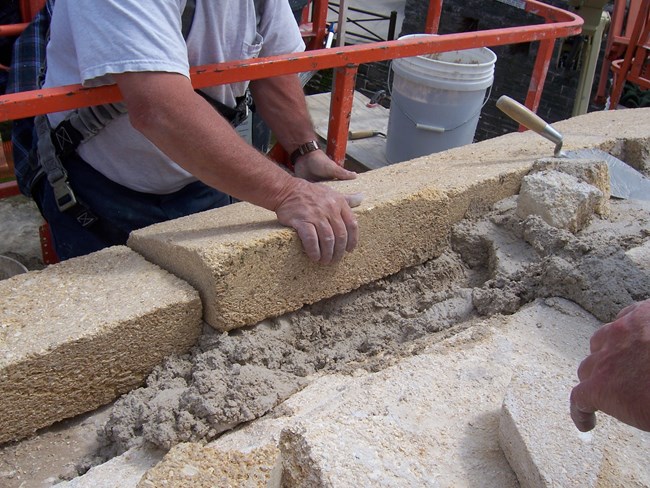
NPS The rock that saved St. AugustineWho would think that a fort made of seashells would last 300 years? Who would think that a fort made out of seashells would last three days under cannon fire?But the Castillo de San Marcos, made of local coquina stone, did and has survived very well for over 300 years. What exactly is this strange rock? How was it formed, and where did it come from? And how did this rock shape the history of St. Augustine? Thousands of years ago, the tiny coquina clam donax variabilis lived in the shallow waters of coastal Florida, as they still do today. These are the small pink, lavender, yellow, or white shells one sees along the beach at the waterline. As the resident clam died, the shells accumulated in layers, year after year, century after century, for thousands of years forming submerged deposits several feet thick. During the last ice age, sea levels dropped, exposing these shell layers to air and rain. Eventually, the shell became covered with soil, then trees and other vegetation. Rain water percolating through the dead vegetation and soil picked up carbon dioxide and became carbonic acid, the same ingredient that makes soda pop fizz. As this weak acid soaked downward, it dissolved some of the calcium in the shells, producing calcium carbonate, which solidified in lower layers much like flowstone and stalactites are formed in caves. This material "glued" the shell fragments together into a porous type of limestone we now call coquina, Spanish for "tiny shell". Although found in very few places in the world, conditions were just right that several deposits of this shell rock formed along the east coast of Florida. The Spanish knew about this rock, and while they might have picked up loose chunks, the people of St. Augustine were primarily soldiers, not stone masons, and so this rock sat mostly unused and unappreciated for years. Wood was more plentiful, at first, and easier to work with. But then the British, settling to the north, edged into the Carolinas. Spanish Florida was only a short sail away. Something more than a wooden fort was needed to protect St. Augustine and to keep the British from taking over Florida and using it as a base of operations to attack the Spanish treasure fleets and the more wealthy colonies of the Spanish Caribbean. So, in 1672, the Spanish began to build the Castillo de San Marcos out of coquina stone from a quarry located in the area of present-day Anastasia State Recreation Area on Anastasia Island. Military engineers and stone masons were brought from Spain. Convicts and additional soldiers were brought from Cuba. Oyster shells were burned into lime, mixed with sand and water to make mortar. Slowly the walls rose. Since no one had ever built a fort or any large building out of coquina, they had no idea how strong it would be. At least it would not burn, and the termites wouldn’t eat it. But how well would seashells last under cannon fire? No one knew, so they built the walls 12 feet (3.7m) thick with the walls on the ocean side 19 feet (5.8 m) thick! They did not have long to wait before the coquina walls were tested. In 1702 James Moore from Charleston led his British forces against St. Augustine and the Castillo. He captured the town and set his cannon up among the houses to bombard the fortress. But a strange thing happened. Instead of shattering, the coquina stone merely compressed and absorbed the shock of the hit! The cannon balls just bounced off or stuck in a few inches! The shell rock worked! (It is not true that the cannonballs were then dug out of the walls and shot back at the enemy. Even when General Oglethorpe tried his hand against St. Augustine in 1740 and bombarded the Castillo for 27 days, the walls held firm. The rock made of seashells turned out to be an excellent building material. When the Spanish decided to fortify the southern approaches to St. Augustine by building Fort Matanzas later that year, they again used coquina stone, and like the Castillo, this smaller fort was never captured, either. This makes one think. What if the Spanish had not had this coquina stone? After all, there is not a lot of exposed rock in Florida and not much clay, either, to make bricks. If not for coquina, perhaps the British would have captured St. Augustine much earlier than 1763 when they finally gained Florida by treaty. If the British had Florida earlier, it might have changed the course of the American Revolution. Maybe our country would still be a part of Great Britain as a commonwealth like Canada! Our history might have been quite different but for this little clam known as donax and for coquina, the rock that saved St. Augustine. |
Last updated: April 10, 2020
